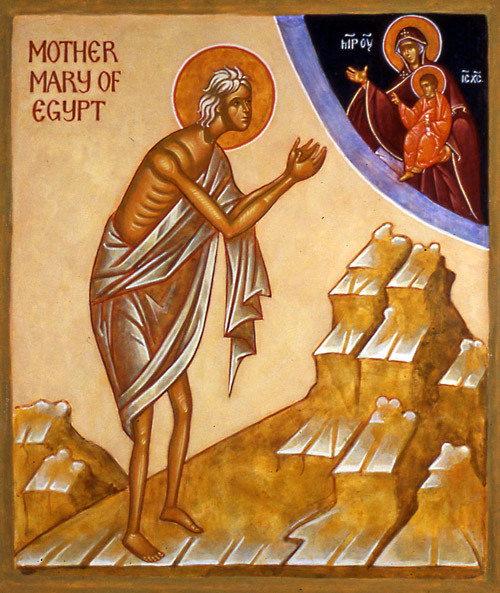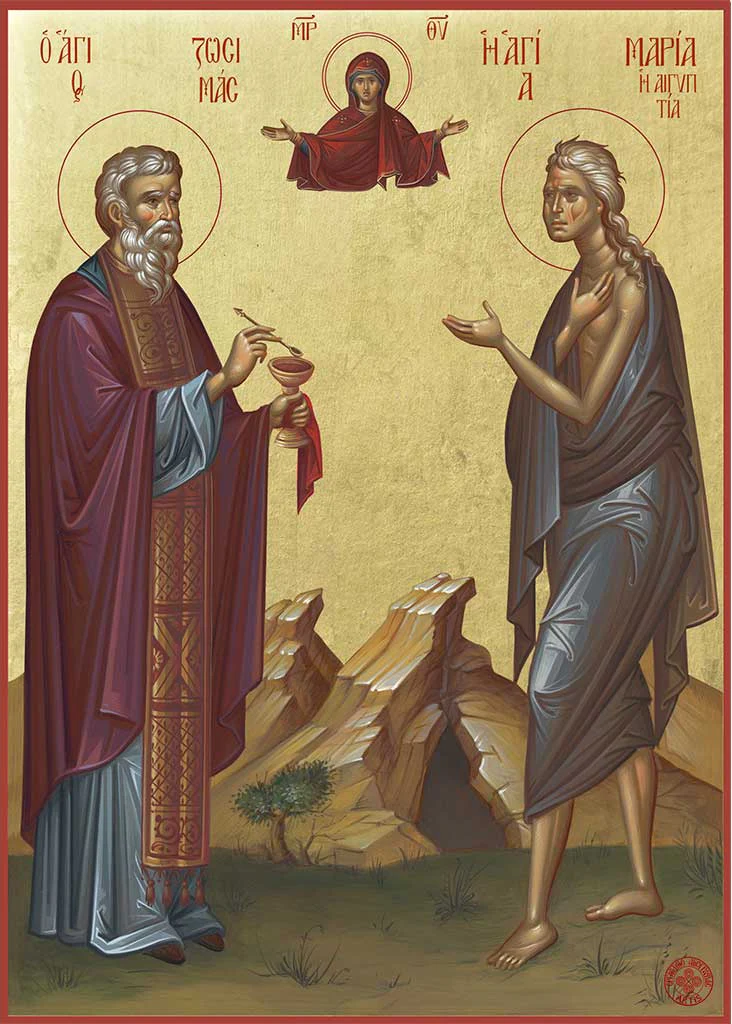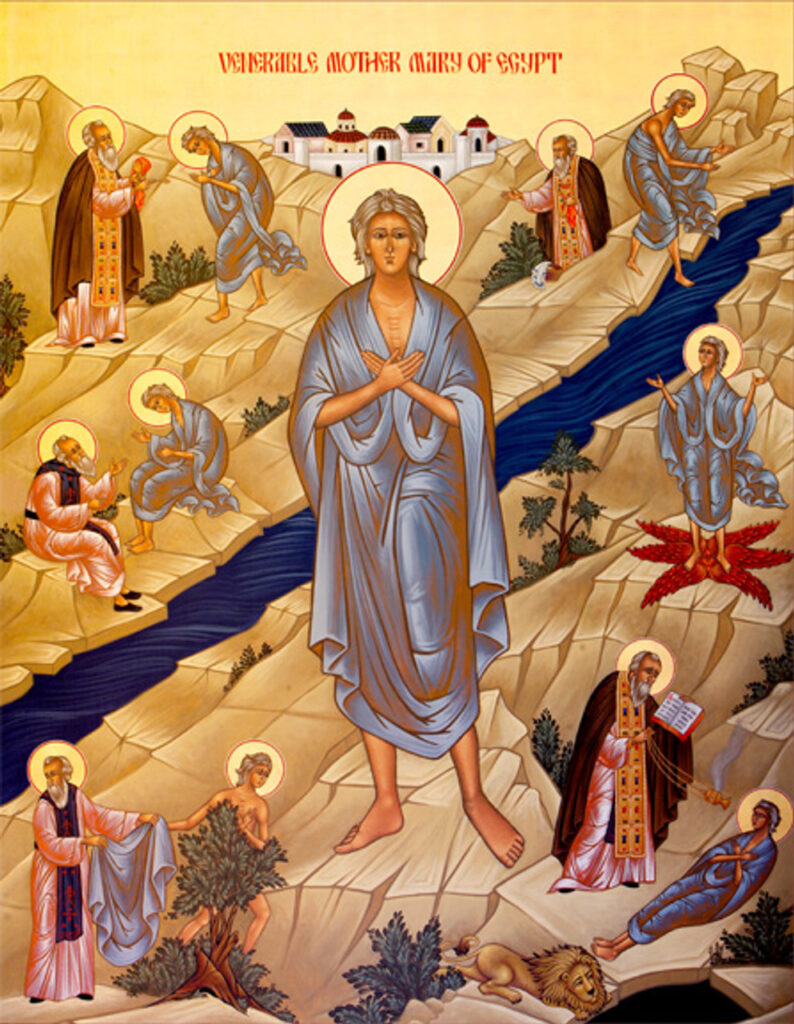Introduction: The Fifth Sunday of Great Lent
On the Fifth Sunday of Great Lent, the Orthodox Church commemorates the life of Saint Mary of Egypt, a woman whose radical transformation from a life of sin to sainthood serves as a powerful testament to God’s boundless mercy. While her official feast day is celebrated on April 1st (the day of her repose), the Church also honors her during Great Lent as a model of repentance—a beacon of hope for all who seek forgiveness and renewal.
Her life, as recorded by Saint Sophronius, Patriarch of Jerusalem (634-638 AD), is read during the Great Canon of Saint Andrew of Crete, inspiring the faithful to embrace true repentance.
The Early Life of Saint Mary of Egypt: A Descent into Sin
Born in Egypt in the 6th century, Mary left home at the young age of twelve and traveled to Alexandria, a bustling city filled with temptations. For the next seventeen years, she lived a life of debauchery, indulging in unrestrained passions. Unlike many who engage in such acts out of necessity, Mary did so willingly, often refusing payment—not for survival, but to feed her insatiable desires.
Her life took a dramatic turn when she encountered a group of pilgrims heading to Jerusalem for the Feast of the Exaltation of the Cross. With no money for passage, she offered her body as payment and joined them.
A Moment of Divine Intervention: Rejected at the Church Doors
Upon arriving in Jerusalem, Mary followed the crowds to the Church of the Resurrection (the Holy Sepulchre). But as she attempted to enter, an invisible force barred her way—no matter how hard she tried, she could not cross the threshold.
Struck with sudden clarity, she realized: her sins were holding her back.
Overcome with remorse, she wept before an icon of the Theotokos (the Mother of God) and cried out:
“O Lady, who bore God in the flesh, I know I am unworthy to look upon your icon, for I am defiled in body and soul. But as the God born of you became man to call sinners to repentance, help me! Let me enter and venerate His Cross, and I vow to renounce the world and follow the path you show me.”
At that moment, the barrier lifted, and she entered the church. After venerating the Holy Cross, she returned to the icon and heard a voice say:
“If you cross the Jordan, you will find rest.”

A Radical Transformation: 47 Years in the Desert
With only three loaves of bread, Mary journeyed into the wilderness beyond the Jordan River. For 47 years, she lived in complete solitude, enduring scorching heat, freezing cold, and relentless spiritual warfare. Her clothes turned to rags, and she survived on meager scraps of bread and wild plants.
The first 17 years were the hardest—tormented by memories of her past sins and violent temptations, she threw herself to the ground, begging the Theotokos for strength. Through prayer, extreme asceticism, and divine grace, she transformed her carnal desires into burning love for God.
The Miraculous Encounter with Saint Zosimas
After nearly five decades in isolation, she was discovered by Saint Zosimas, a monk who had ventured into the desert for Great Lent. At first, he thought she was a phantom—a naked, sun-scorched figure with hair white as snow.
But she called him by name, asking for his cloak to cover herself. Astonished, he listened as she recounted her entire life story, demonstrating supernatural knowledge of Scripture despite never having been taught.
Before parting, she asked him to return the next year on Holy Thursday with the Holy Eucharist. When he did, he witnessed a miracle: Mary crossed the Jordan River by walking on water to receive Communion.
After receiving the Body and Blood of Christ, she wept, quoting the words of Simeon the God-Receiver:
“Lord, now lettest Thou Thy servant depart in peace, for mine eyes have seen Thy salvation.” (Luke 2:29)
She then asked Zosimas to meet her again one year later in the same place.

The Holy Repose of Saint Mary of Egypt
When Zosimas returned, he found her lifeless body, arms crossed, facing eastward. Written in the sand beside her was a message:
“Father Zosimas, bury the body of humble Mary. Return to dust what is dust. Pray for me. I died on April 1st, the very night I received the Holy Mysteries.”
But how had her body traveled so far from the Jordan in just one day? It was a miracle—God had transported her.
As Zosimas struggled to dig a grave, a lion appeared and, at his command, used its claws to dig. After burying her, the monk returned to his monastery, spreading the incredible story of her repentance.
Why the Church Honors Saint Mary of Egypt During Great Lent
Saint Mary’s life is a dramatic witness to the power of repentance. Her story reminds us:
No sin is too great for God’s mercy.
True repentance requires complete surrender.
Transformation is possible, even at the “eleventh hour.”
As we near the end of Great Lent, her example calls us to:
Examine our own hearts.
Turn away from sinful habits.
Embrace God’s healing grace.
A Prayer Through Saint Mary’s Intercession
O Christ our God, through the prayers of our venerable mother Mary of Egypt, have mercy on us and save us. Amen.
May her radical conversion inspire us all to seek true repentance and draw nearer to God!
SEO Keywords:
Saint Mary of Egypt
Fifth Sunday of Great Lent
Repentance in Orthodoxy
Life of Saint Mary of Egypt
Great Lent repentance
Orthodox saints
Saint Zosimas and Mary of Egypt
Miracles of repentance
How to repent like Saint Mary of Egypt

